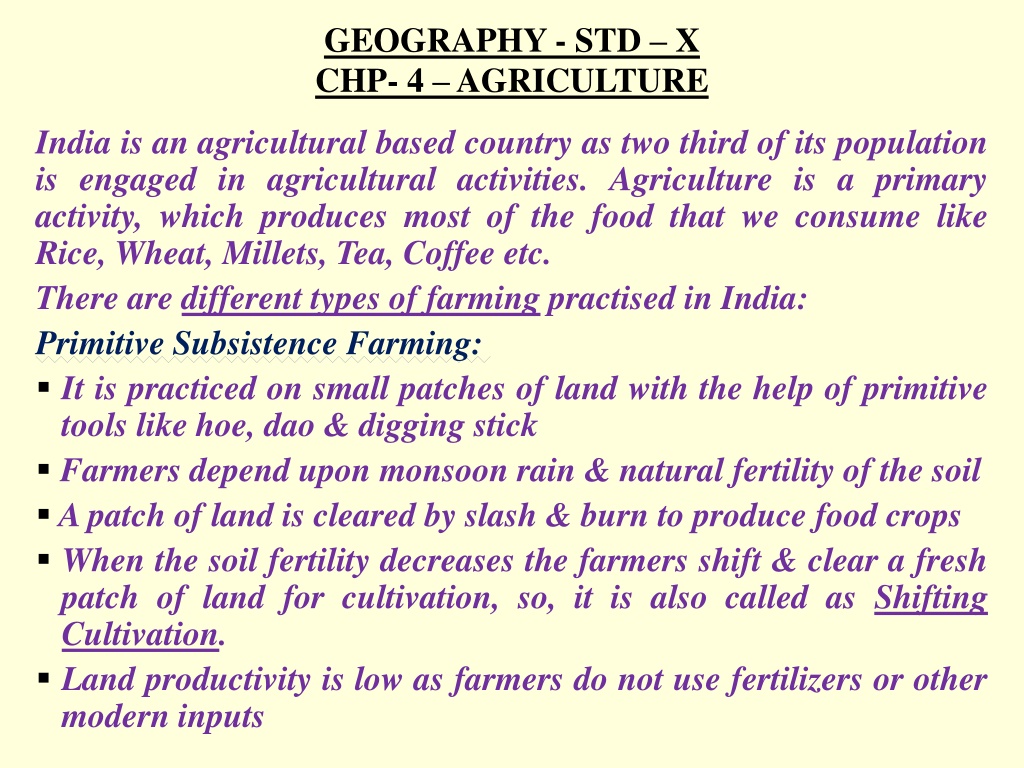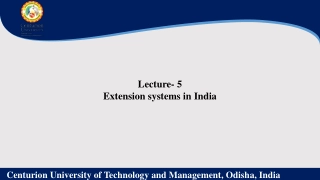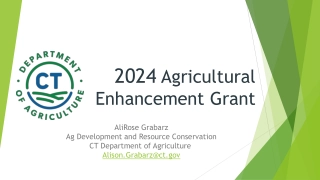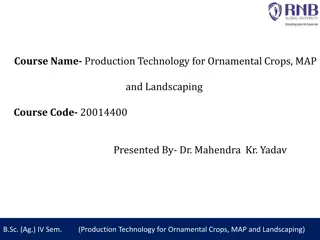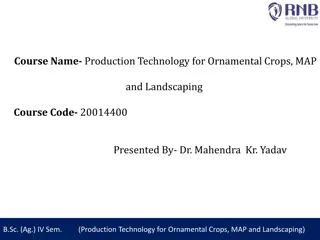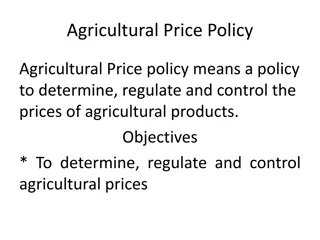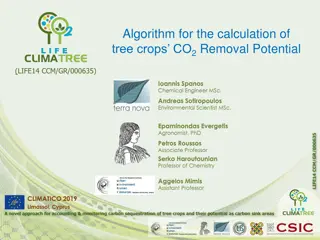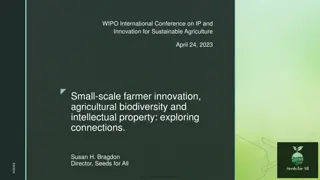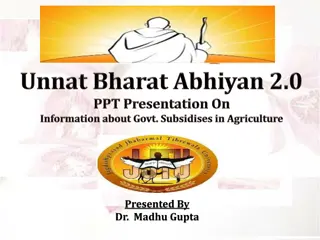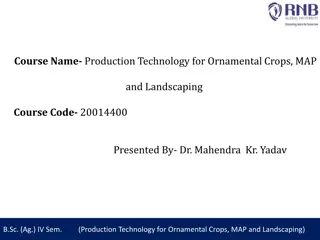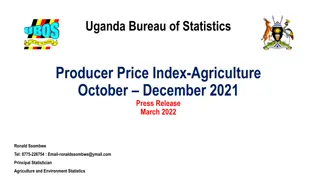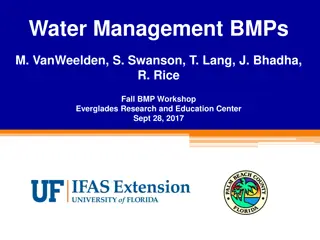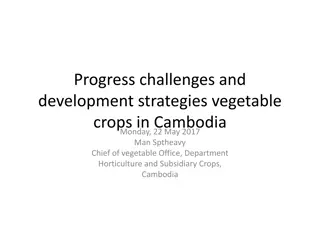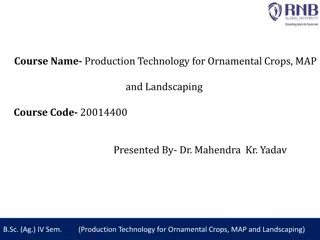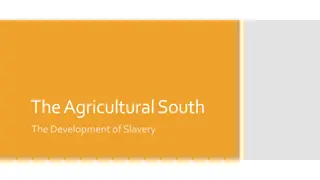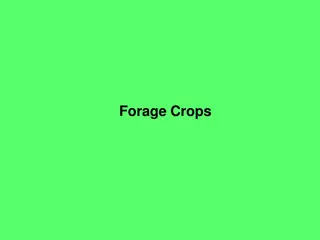Agricultural Practices and Major Crops in India
India is predominantly an agricultural-based country with two-thirds of its population engaged in farming. The country practices different types of farming, including primitive subsistence farming, intensive subsistence farming, and commercial farming. The cropping seasons in India are classified as Rabi, Kharif, and Zaid. Major crops grown in various regions of India include rice, wheat, millets, maize, sugarcane, tea, coffee, rubber, cotton, and jute, each requiring specific temperature, rainfall, and soil conditions.
Download Presentation

Please find below an Image/Link to download the presentation.
The content on the website is provided AS IS for your information and personal use only. It may not be sold, licensed, or shared on other websites without obtaining consent from the author. Download presentation by click this link. If you encounter any issues during the download, it is possible that the publisher has removed the file from their server.
E N D
Presentation Transcript
GEOGRAPHY - STD X CHP- 4 AGRICULTURE India is an agricultural based country as two third of its population is engaged in agricultural activities. Agriculture is a primary activity, which produces most of the food that we consume like Rice, Wheat, Millets, Tea, Coffee etc. There are different types of farming practised in India: Primitive Subsistence Farming: It is practiced on small patches of land with the help of primitive tools like hoe, dao & digging stick Farmers depend upon monsoon rain & natural fertility of the soil Apatch of land is cleared by slash & burn to produce food crops When the soil fertility decreases the farmers shift & clear a fresh patch of land for cultivation, so, it is also called as Shifting Cultivation. Land productivity is low as farmers do not use fertilizers or other modern inputs
Intensive Subsistence Farming: This type of farming is practiced in the areas of high population It is labour intensive farming High doses of bio chemical inputs & irrigation are used for higher production Land holding is small & uneconomical Farmers continue to take maximum output from the limited land, thus, enormous pressure on agricultural land is seen Commercial Farming: Farming land is huge Higher doses of modern inputs, HYV seeds, chemical fertilizers, insecticides & pesticides are used for high production Asingle crop is grown on a large area, capital investment is high Production is used as raw material in different industries They need well developed modes of transport & communication
CROPPING SEASONS Rabi Kharif Zaid Crops are sown in winter from Oct-Dec Crops are sown with the onset of monsoon Crops are grown in between Rabi & Kharif Harvested in Summer from April June Harvested in Sep-Oct Harvested in Summer Eg: Wheat, Barley etc. Eg: Paddy, Maize etc. Eg: Watermelon, Cucumber etc.
MAJOR CROPS A variety of food & non food crops are grown in different parts of the country depending upon variations in soil, climate & cultivation practices. CROPS TEMP RAINFALL SOIL AREAS Rice > 25 C 100-120 cm Alluvial West Bengal, Odisha Wheat 10-20 C 50-75 cm Alluvial loamy Punjab, Haryana Millets (a)Jowar (b) Bajra (c) Ragi Maize 50-75 cm < 50 cm 50-75 cm > 75 cm Black Sandy Red, Black Alluvial(Bhangar) Maharashtra,Karnataka Rajasthan, UP Karnataka, Tamil Nadu Karnataka, UP > 25 C 21-27 C Sugarcane 21-27 C 75-100 cm Alluvial, Black UP, Maharashtra Tea > 25 C 200-250 cm Laterite Assam, West Bengal Coffee > 25 C > 250 cm Laterite Nilgiri in Karnataka, Kerala & Tamil Nadu Kerala, Tamil Nadu Rubber > 25 C > 200 cm Laterite Cotton > 25 C 50-75 cm Black Maharashtra, Gujarat Jute > 25 C 100-150 cm Alluvial (Khadar) West Bengal, Assam
Sustained uses of land without compatible techno-institutional changes have hindered the pace of agricultural development in spite of development of sources of irrigation most of the farmers in the country still depend upon monsoon & natural fertility which poses a serious challenge. Thus, government has introduced certain reforms in agriculture. Technical Reforms: Collectivisation & Consolidation of holdings Cooperation & abolition of zamindari Introduction of Green Revolution in agriculture & White Revolution in milk production Introduction of Tractors, Harvestors, Threshers & Tubewells etc For better production Fertilisers, Insectisides & Pesticides were produced Government announced minimum support price to check exploitation of farmers by middle men
Institutional Reforms: Establishment of Banks for providing loan facilities to the farmers at low rate of interest Grameen Banks, Co-operative societies & Provisions of crop insurance against drought, flood, cyclone, fire & disease Introduction of Kissan Credit Card, Personal Accident Insurance Scheme by government of India for the benefit of farmers Special Weather Bulletins & agricultural programmes like Krishi Darshan were introduced on Radio & Television
Impact of Globalisation on Indian Agriculture: Globalisation was present even at the time of British colonisation After 1990, the farmers in India have been exposed to new challenges under Globalisation Genetic engineering is revolutionising the agricultural production now a days Organic Farming is in great demand because it is practised without factory made chemicals such as fertilisers & pesticides. Hence, it doesn t affect environment in a negative manner Indian farmers should diversify their cropping pattern from cereals to high value crops which will increase incomes & reduce environmental degradation simultaneously
HOME ASSIGNMENT i. On an outline map of India, show 2 major crop growing states- Rice, Wheat, Sugarcane, Rubber, Maize, Tea, Coffee, Cotton, Jute ii. Distinguish between Primitive Subsistence Agriculture & Intensive SubsistenceAgriculture iii. What type of climate is required for the production of Sugarcane? Give some bi-products of Sugarcane iv. Give reasons to why Subsistence Agriculture is still practised in certain parts of the country ********* - Mrs. Shyama Barpanda TGT (GEOGRAPHY)
